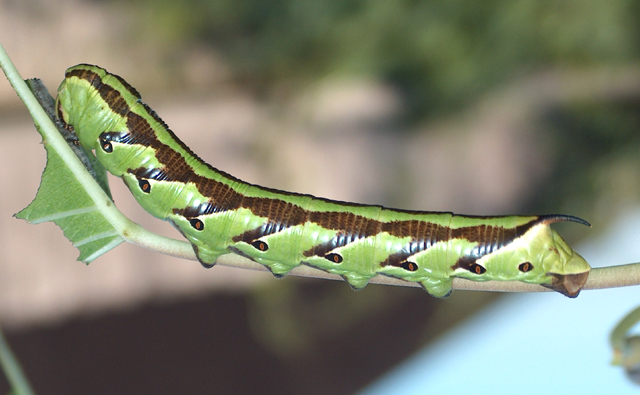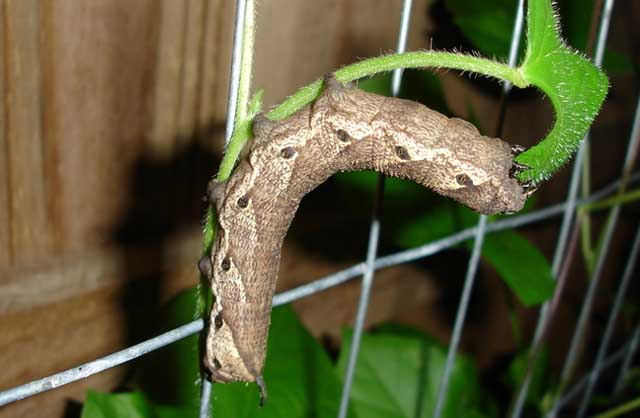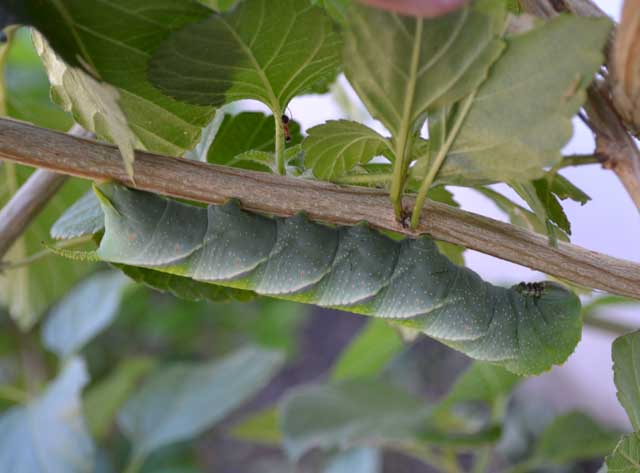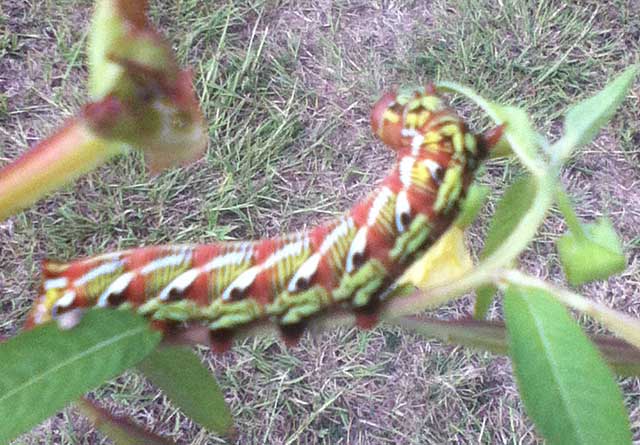Sphinginae subfamily
Sphingini tribe:
 |
Larvae feed on plants in the Convolvulaceae family, especially
Ipomoea batatas (sweet potato) and in the Solanaceae family,
especially (Datura) (jimsonweed) and related plants in the
Americas. There is also a brown form. Look for very large, dark
spiracular circles.
|
 |
Ceratomia amyntor
USGS,
the Elm Sphinx or Four-horned Sphinx
Larvae feed on Elm (Ulmus), birch (Betula), basswood
(Tilia), and cherry (Prunus).
There are both green and brown forms. The four horns near
the head are diagnostic.
|
 |
Young caterpillars feed gregariously on Catalpa species
(Catalpa bignoniodes and C. speciosa) in the
Bignoniaceae family, skeletonizing the foliage.
Larvae are mostly white in early instars.
generally more eastern species
|
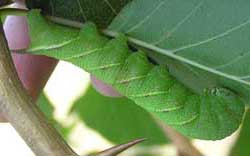 |
Ceratomia hageni
USGS, Hagen's Sphinx or Osage Orange Sphinx
Larvae feed on osage orange (Maclura pomifera), and they have a granulous appearance with variable amounts of purple
along the oblique white stripes.
|
 |
Fraxinus, Ligustrum, Quercus, Crataegus and
Chionanthus virginicus are listed as hosts.
In the fifth instar, the spiracular ovals are decidedly red and the
anal horn is off-white to pinkish laterally.
|
 |
Dolba hyloeus
USGS, the Pawpaw Sphinx
Larvae feed on pawpaw (Asimina triloba), littleleaf sweetfern
(Myrica aspleniifolia), possum haw (Ilex decidua), and
inkberry (Ilex glabra) as well as Tall Gallberry Holly
(Ilex coriacea).
Louis Handfield reports larvae probably feed on Ilex verticellata
in Quebec.
generally more eastern species
|

|
Isoparce cupressi
USGS, Cypress or Baldcypress Sphinx.
Larvae feed on needles of baldcypress (Taxodium distichum) at night and
pupate in shallow underground burrows where second generation
overwinters.
|
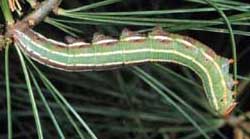 |
The caterpillars, with their green, white and rust coloured lines,
are well camouflaged on pine.
|
| Larval hosts are unknown to me.
Sorry, no larval image is available at this time.
|
 |
The caterpillars are called Tomato Hornworms and each has a black horn at the end of the abdomen.
Larvae feed on potato, tobacco, tomato, and other plants in the
nightshade family (Solanaceae).
|
 |
Manduca rustica
USGS/JK, the Rustic Sphinx
The caterpillar has numerous white nodules on top of the thorax and
seven pairs of oblique, blue-gray stripes along the side of the body.
The horn is white at the base and blue-gray at the tip, also with white nodules.
|
Manduca rustica, Pearland, October 13, Josh Kirk
 |
Tobacco Hornworms, equipped with a red-tipped horn at the end of the
abdomen, are true gluttons and feed on tobacco and tomato, and
occasionally potato and pepper crops and other plants in the
nightshade family (Solanaceae).
|
 | Preferred hosts are common trumpetcreeper (Campsis radicans),
Florida yellow-trumpet (Tecoma stans), lilac
(Syringa species), and
passionflower (Passiflora species).
The anal horn is blue, preceded by a yellow dash.
|
Smerinthini Tribe:
 |
Amorpha juglandis larvae feed upon Walnut and butternut (Juglans),
hickory (Carya), alder (Alnus), beech (Fagus),
hazelnut (Corylus), and hop-hornbeam (Ostrya).
|
 |
Pachysphinx modesta
USGS/CM,
the Modest Sphinx or Poplar Sphinx
Larvae feed on poplars and cottonwood.
|
Pachysphinx modesta on cottonwood, Houston, Harris County, June 20, Cory Melancon
 |
Larvae accept willows, birches, and cherries.
I have also found them in the wild on oak in eastern Canada.
generally more eastern species
|
 |
Paonias myops
USGS,
the Small-eyed Sphinx
The caterpillars have a grainy appearance with weak oblique lines
and varying amounts of red spotting on their sides.
|
 |
Larvae feed upon many forest trees including birches and cherries,
but are expecially fond of poplars and willows. Red markings on sides
vary greatly from specimen to specimen.
|
Macroglossinae subfamily
Dilophonotini tribe:
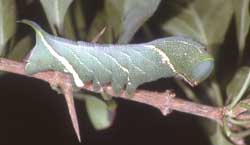 |
Larvae feed on various species of the Rubiaceae (madder) family.
Randia rhagocarpa, Randia monantha, Randia aculeata, Guettarda
macrosperma and Genipa americana are listed as hosts. Probably only further south.
|
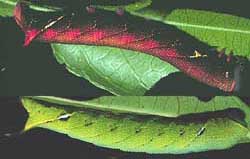 |
Larvae feed on various species of the Rubiaceae (madder) family,
including Genipa americana and Alibertia edulis
and Randia species. There are at least two color morphs, a green form and a
much darker, reddish-brown form. rare
|
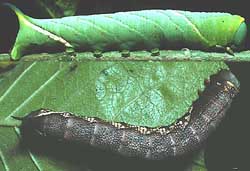 |
Larvae feed on seven year apple, Casasia clusiifolia, common
buttonbush, Cephalanthus occidentalis, and white indigoberry,
Randia mitis. Randia monantha, Randia aculeata,
Albizzia adinocephala and Randia grandifolia, all in the
madder family (Rubiaceae), also serve as hosts.
rare
|
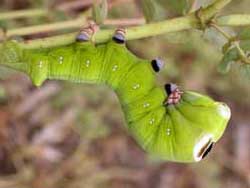 |
Larvae feed on papaya (Carica papaya), Cnidoscolus
angustidens, poinsettia (Euphorbia pulcherrima),
guava (Psidium species) and
saffron plum (Bumelia angustifolia/Bumelia celastrina).
Manilkara bahamensis,
Willow Bustic (Bumelia salicifolia)
and Painted Leaf (Poinsettia heterophylla) are also hosts.
Nice socks! Larvae show considerable variation.
|
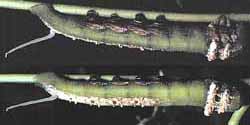 |
Larvae feed on papaya (Carica papaya), Manihot esculenta
and various plants (Macroscepis obovata) in the milkweed
family.
might be present in southern portions of this
region.
|
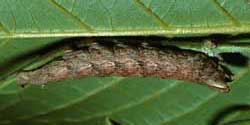 |
Erinnyis obscura, the Obscure Sphinx,
USGS
Larvae feed on Rauvolfia ligustrina, Rauvolfia tetraphylla,
Stemmadenia obovata, Philibertia, Cynanchum, papaya
(Carica papaya), Asclepiadaceae, Blepharodon mucronatum,
White vine (Sarcostemma clausum) and Morrenia odorata.
rare
|
See Hemaris comparison to help distinguish
the next two species.
 |
Hemaris thysbe
USGS, the Hummingbird Clearwing
There is also an orangey-pink prepupal form. The lateral line runs
from S1 to the blue horn.
Hemaris thysbe larvae feed on viburnum and related plants.
generally more eastern species
|
 |
Hemaris diffinis
USGS, the
Snowberry Clearwing or Bumblebee Moth
Larval host plants include Snowberry (Symphoricarpos),
honeysuckle (Lonicera), Coralberry, viburnums, Blue Dogbane
(Apocynum) and dwarf bush honeysuckle (Diervilla lonicera).
Horn is black with a yellow base.
|
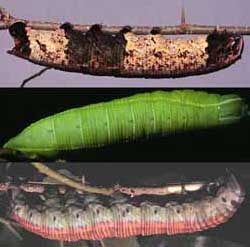 |
Females feed and lay eggs on fig leaves, especially Strangler Fig
(Ficus aurea). Ficus carica, Ficus microcarpa, Ficus
religiosa, Ficus pumila, Ficus gamelleira, Ficus prinoides, Ficus
pumila and Artocarpus integrifolia are also listed as
hosts.
The extreme variability of larvae is shown to the left.
The few images that have been sent to me for identification help
are usually as per the upper image.
|
Philampelini tribe:
 |
Larvae feed upon Grape (Vitis), Virginia Creeper
(Parthenocissus quinquefolia) and other vines and ivies
(Ampelopsis).
Larvae occur in both a light (green) form and a darker (tan/brown)
form. Note six "segmented" oblique lines.
|
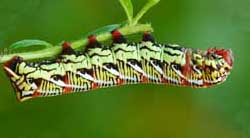 |
Eumorpha fasciatus
USGS/CF, the Banded Sphinx
Larvae feed upon primrose-willow, Ludwigia (water primrose)
and other plants in the evening primrose family. This hornless larva is
highly variable. Look for large, dark spiracular circles and a dark
line in the center of the back. See image at bottom of this page.
|
Eumorpha fasciatus fifth instar, College Station, Brazos County, October 4, 2012, Callie Farrell.
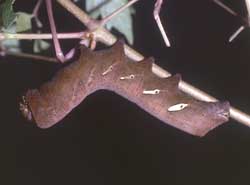 |
Eumorpha intermedia
WO, the Intermediate Sphinx.
Eumorpha intermedia larvae feed upon peppervine, Ampelopsis arborea. Possibly they will also accept grape (Vitis species),
but so far no records of that host have been reported to my knowledge.
They like to remain well hidden within tangle of vines and probably feed mostly at night.
|
 |
If you have Grape or Virginia Creeper nearby, then you might encounter
this species. Note the five large white ovals. There are orangey-brown and green
forms also.
generally more eastern species
|
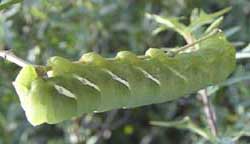 |
Eumorpha vitis
USGS/Amy Smith/ML,
the Vine Sphinx
Eumorpha vitis vitis larvae feed upon grape foliage (Vitis) and
other vines (Cissus): Cissus pseudosicyoides
and Cissus rhombifolia and Cissus sicycoides.
I suspect there would be a brown form.
Note five, smooth, narrow, oblique white lines.
|
Macroglossini tribe:
 |
In additon to Virginia creeper larvae accept Grape (Vitis),
ampelopsis (Ampelopsis), and cayenne pepper (Capsicum).
Larvae are green until the final instar.
|
 |
Larvae feed on Azalea and Viburnum and progress very rapidly. The
larva to the left on Viburnum cassinoides is getting ready to
pupate. Color change from green to light burgundy-brown indicates
pupation is imminent. |
 |
Darapsa myron
USGS, the Virginia Creeper Sphinx or the Grapevine Sphinx
If you have the
foodplants indicated in the common names, you probably have this
species nearby. The lower wings are orange.
Larvae feed on Virginia creeper (Parthenocissus quinquefolia),
Grape (Vitis), Ampelopsis, and Viburnum.
|
 |
Larvae feed on Smooth hydrangea (Hydrangea arborescens),
buttonbush (Cephalanthus occidentalis), and waterwillow
(Decodon verticillatus).
Note small head which can be retracted into the thorax.
|
 |
Grape (Vitis), ampelopsis (Ampelopsis), and
Virginia creeper (Parthenocissus) all serve as larval hosts.
The alternating yellow and greyish-green rings across the back
distinguish this larva.
|
Deidamia inscriptum March, 15, 2008, Bexar Co.,
Michael van Buskirk.
 |
Hyles lineata
USGS, the White-lined Sphinx
Larvae are highly varied and feed on a great diversity of plants
including willow weed (Epilobium), four o'clock (Mirabilis),
apple (Malus), evening primrose (Oenothera), elm
(Ulmus), grape (Vitis), tomato (Lycopersicon),
purslane (Portulaca), and Fuschia.
All larvae seem, however, to have the red/black swellings split by
dorso-lateral lines. |
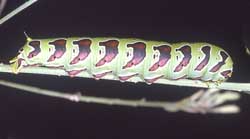 | Larvae feed on (Onagraceae) including evening primrose
(Oenothera), gaura (Gaura), and willow weed
(Epilobium).
rare
|
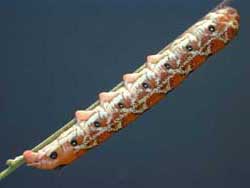 |
Larvae feed on (Onagraceae) including evening primrose
(Oenothera), gaura (Gaura), and willow weed
(Epilobium).
Larvae are green with a short red horn in fourth instar.
rare
|
 |
Larvae feed at night on grape (Vitis) and ampelopsis
(Ampelopsis) and hide on the bark of their host plants during
the day. Virginia creeper would also be a suitable host. There is also a dark form
without the green patches. Note the "raised eye", replacing the anal horn.
generally more eastern species
|
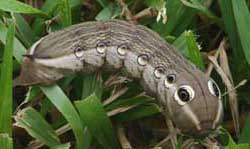 |
Larvae also feed on Borreria, Catalpa and Manettia spp. and
Smooth buttonplant (Spermacoce glabra) and starclusters
(Pentas species). They are also recorded on joe-pie weed and
Hamelia patens and on Hedoydis nigricans. The green form may be more
common.
|
|
|
